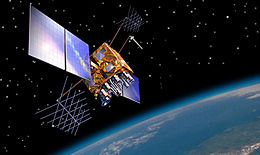USA-196
 A Block IIRM GPS satellite | |
| Mission type | Navigation |
|---|---|
| Operator | US Air Force |
| COSPAR ID | 2007-047A[1] |
| SATCATno. | 32260[1] |
| Mission duration | 10 years (planned) |
| Spacecraft properties | |
| Spacecraft type | GPS Block IIRM[2] |
| Bus | AS-4000[2] |
| Manufacturer | Lockheed Martin[2] |
| Launch mass | 2,032 kilograms (4,480 lb)[2] |
| Start of mission | |
| Launch date | 17 October 2007, 12:23:00UTC |
| Rocket | Delta II7925-9.5,D328[3] |
| Launch site | Cape CanaveralSLC-17A[3] |
| Orbital parameters | |
| Reference system | Geocentric |
| Regime | Medium Earth (Semi-synchronous) |
| Perigee altitude | 20,149 kilometers (12,520 mi)[4] |
| Apogee altitude | 20,214 kilometers (12,560 mi)[4] |
| Inclination | 54.8 degrees[4] |
| Period | 717.94 minutes[4] |
USA-196,also known asGPS IIR-17(M),GPS IIRM-4andGPS SVN-55,is an Americannavigation satellitewhich forms part of theGlobal Positioning System.It was the fourth of eightBlock IIRMsatellites to be launched, and the seventeenth of twenty oneBlock IIRsatellites overall. It was built byLockheed Martin,using theAS-4000satellite bus.[2]
USA-196 was launched at 12:23:00 UTC on 17 October 2007, atop aDelta IIcarrier rocket, flight number D328, flying in the 7925-9.5 configuration.[3]The launch took place fromSpace Launch Complex 17Aat theCape Canaveral Air Force Station,[5]and placed USA-196 into a transfer orbit. The satellite raised itself intomedium Earth orbitusing aStar-37FMapogee motor.[2]
By 27 October 2007, USA-196 was in an orbit with aperigeeof 20,149 kilometers (12,520 mi), anapogeeof 20,214 kilometers (12,560 mi), aperiodof 717.94 minutes, and 54.8 degrees ofinclinationto the equator.[4]It is used to broadcast the PRN 15 signal, and operates in slot 2 of plane F of the GPS constellation. The satellite has a design life of 10 years and a mass of 2,032 kilograms (4,480 lb).[2]As of 2015 it remains in service.
References[edit]
- ^ab"GPS 2R-17".US National Space Science Data Center.Retrieved11 July2012.
- ^abcdefgKrebs, Gunter."GPS-2RM (Navstar-2RM)".Gunter's Space Page.Retrieved11 July2012.
- ^abcMcDowell, Jonathan."Launch Log".Jonathan's Space Page.Retrieved11 July2012.
- ^abcdeMcDowell, Jonathan."Satellite Catalog".Jonathan's Space Page.Retrieved11 July2012.
- ^McDowell, Jonathan."Launch List".Launch Vehicle Database.Jonathan's Space Page.Retrieved11 July2012.
